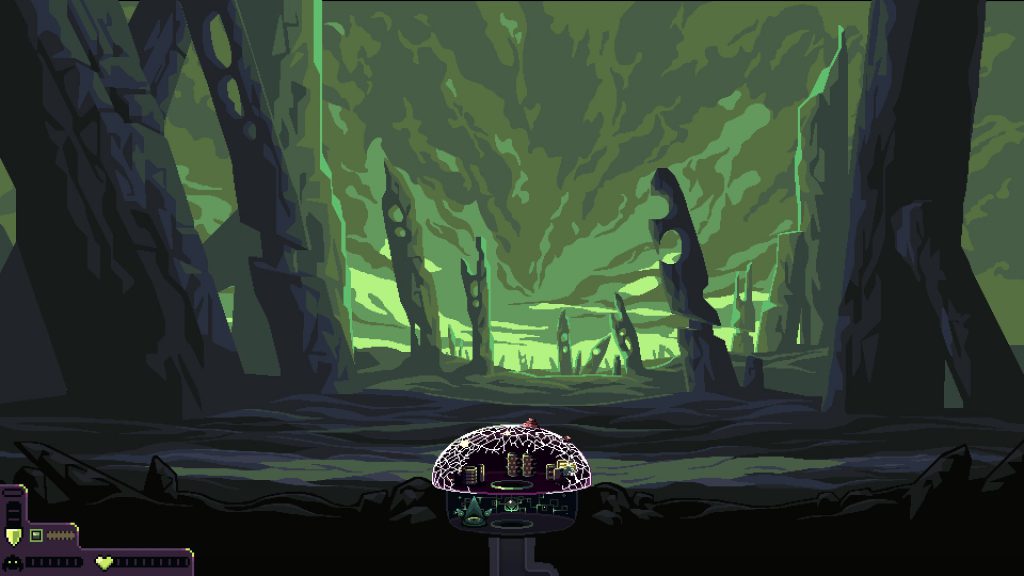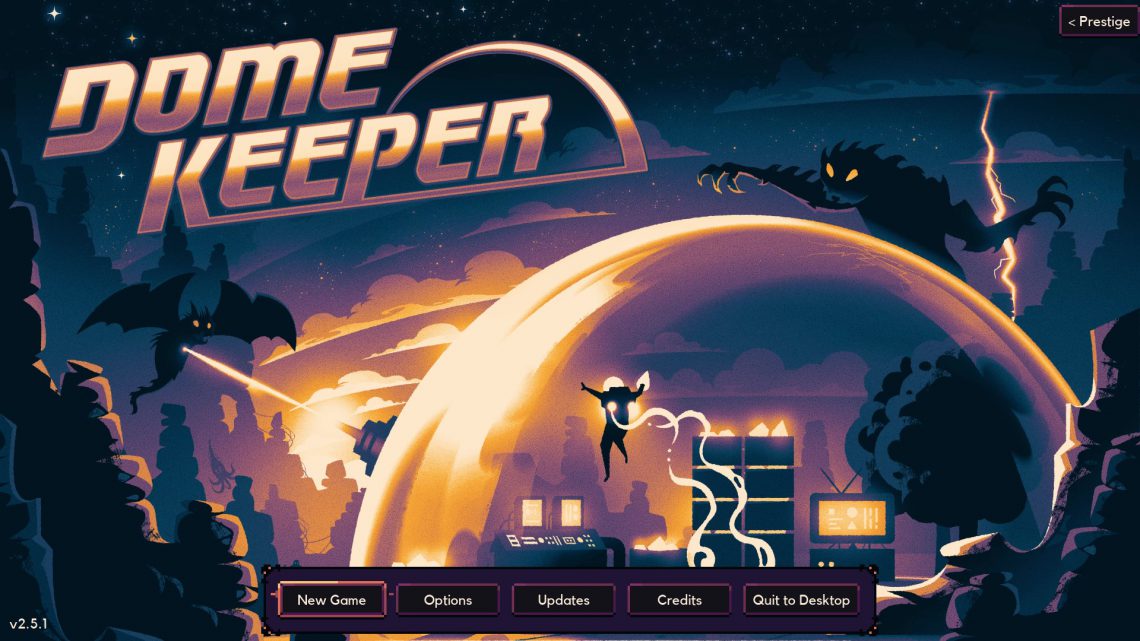I discovered the game Dome Keeper in October of 2022. It’s a Godot game, and it had a cool premise—tower defense mixed with resource mining in a sci-fi atmosphere—so I bought it. Since then, I’ve played Dome Keeper on a near-daily basis, and I haven’t gotten tired of it yet.
Why do I like it so much? I decided to analyze the gameplay and try to figure that out. If I can understand why I like playing a particular game, that will help me figure out how to better design my own games.
I decided to focus on two categories: the gameplay of Dome Keeper itself, and the “environment” surrounding how and when I play Dome Keeper. Both impact my overall feeling for the game and why it’s so much fun for me to play.
I totally didn’t get distracted playing Dome Keeper while writing the blog post, I was doing field research!
The Gameplay
There are three parts to Dome Keeper’s gameplay: mine digging, resource management, and monster fighting. Additionally, there are a number of “rush moments” where these three systems come together to create awesome moments.

Mine Digging
Digging a mine is simple: move down below the dome and start drilling into the nearest block (if you’re the Engineer character, anyway). This feels like digging mines in Minecraft (another activity I’ve done a lot). Why do I like it? I think it has to do with being able to structure a plan for what an “ideal” mine shaft looks like and then imprint that pattern onto the pixelated rock tiles.
I’ll be ignoring the Assessor character for this post because I almost solely play as Engineer; it just fits my preferred style of play better.
I’m not content with just digging tunnels, though; I need a goal in doing so. That objective is finding new resources: iron, water, and cobalt. These resources all contribute to improving my capabilities (more on that in a bit), so they have endogenous value within the game. Because of that value, they’re worth finding, so it gives me a small burst of dopamine when I find them. The way I dig my tunnels allows me to ensure I don’t miss finding anything.
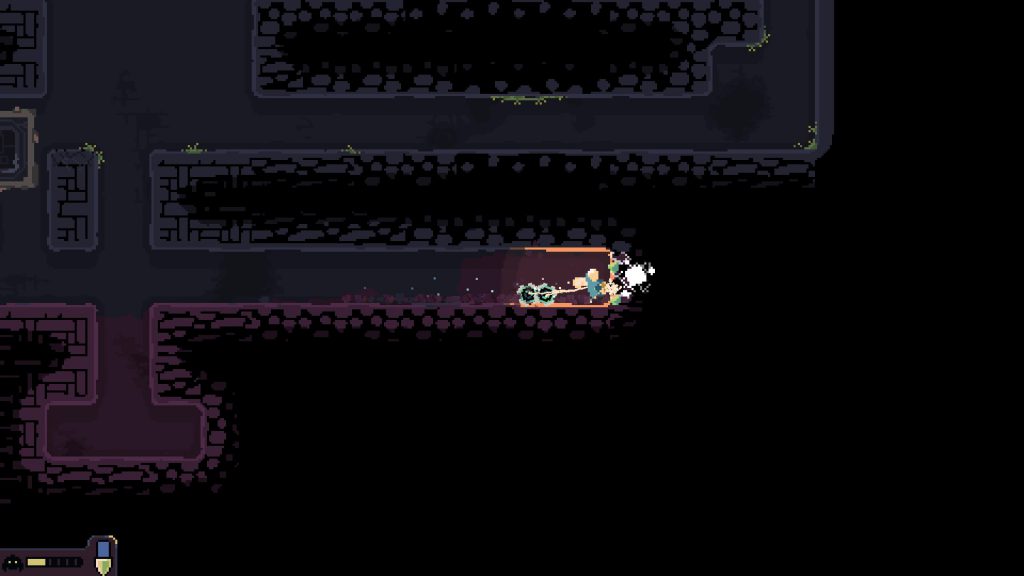
Finding iron, water, and cobalt is only part of the mining story; I also have to carry those resources back through the mine shafts to my dome, where they are processed for use. At the beginning, the game limits how many resource units I can carry, resulting in a cap to how quickly I can mine. Over time, I can upgrade this carry limit, so the efficiency improves. That visible sense of progress feels good as I play, and it further feeds into the value resources have.
There’s other things which can be found underground, too. The other main discoverable items are gadgets, which you have to dig out and carry back to your dome. Once there, they provide some beneficial functionality, including the ability to teleport between your base and a movable portal (Teleporter), a gravity lift which pulls resources in it up to the dome (Lift), and high-powered explosives you can drop to destroy lots of rocks at once (Blast). There are also other minor things to discover under the rocks which aren’t directly part of the dome, like a small creature that ferries one resource at a time, a seed which you can plant on a resource to create a “tree” growing that resource, and a device that, when activated with two iron cubes, gives you X-ray vision to see through two layers of rock. These things add a touch of surprise when you come across them in your digging, and the variety which can be found keeps things interesting.
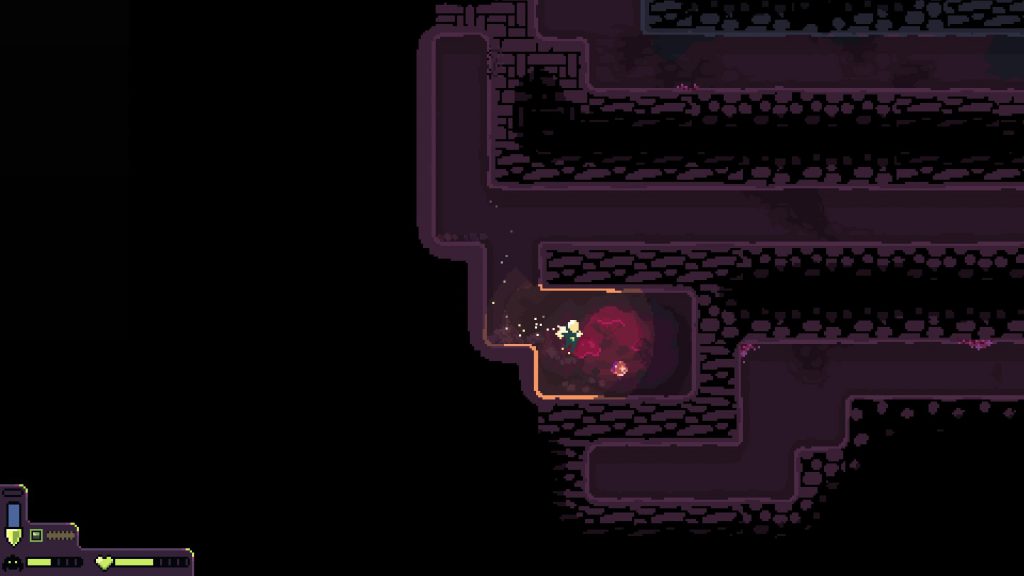
Finding resources and helpful items is only one facet of Dome Keeper’s gameplay. Once you bring those things back to your base, you need to do something with them.
Once your resources have been brought back for processing, you get to choose where to spend them. There are multiple things you can upgrade, and making the right choices about which upgrades to get when is important.
Resource Management
You are underpowered when you start a new run of Dome Keeper; it takes quite a few hits for your drill to break apart the rock, and even longer when that rock contains a resource. The first thing I always do is to mine enough iron to increase my drill’s power so I can dig faster. Immediately this provides visible feedback in the form of faster digging, and passive feedback in that I can get future upgrades sooner. This kind of tangible feedback feels great, and it keeps building up with each upgrade you purchase.
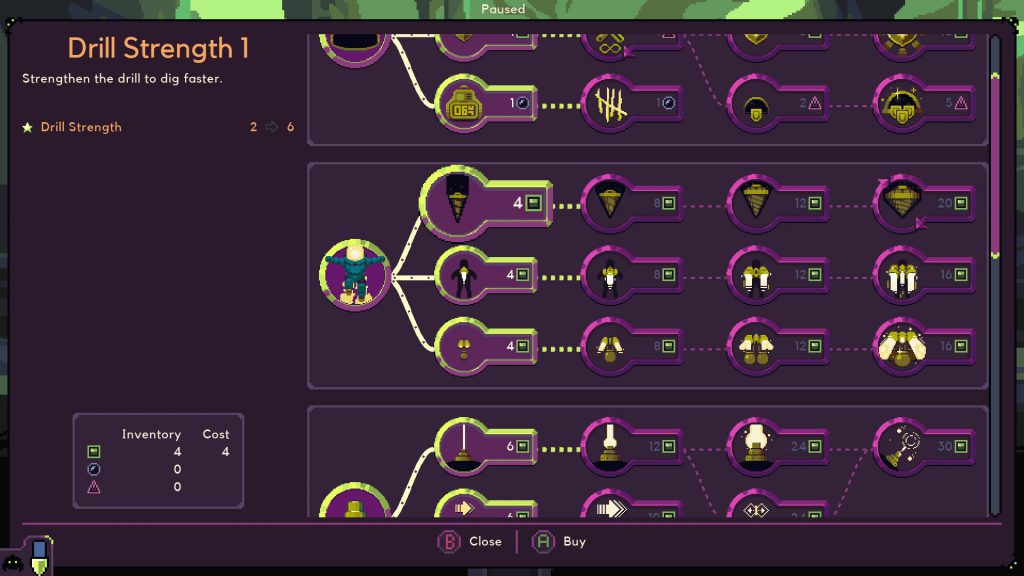
I didn’t have to choose upgrading the drill first, though; I could also have chosen to upgrade my mining speed, or the power of the laser weapon on my dome, or even the ability to see how much time I have before monsters come within firing range of the dome. There’s a plethora of choices to make, and strategizing to buy upgrades at the right time in order to maximize my chances of survival is enthralling. Even choices which feel worthless (like buying an indicator that tells me how many waves I’ve survived) feed into the thrill of strategic decision making; by having some options that are obviously worthless, it gives me the thrill of knowing I’m making a correct choice by avoiding them.
The dome and the keeper aren’t the only things to upgrade, either. The gadgets you find buried under the dome also have their own small upgrade tree, which makes them even more fun to use. Some of the upgrades improve efficiency, like adding additional orbs to the Lift to bring more resources back faster. Others change gameplay entirely, like the Teleporter gaining the ability to teleport resources and providing an alternate means of getting resources back to your base. As I play, I also develop partiality towards certain gadgets based on how I like to play (teleporter and lift are go-to gadgets) while others have less value (like the probe and the Drillbert robot). If I bring back a gadget and it turns out to be something I don’t want, I get to choose to shred it for cobalt, which helps prevent me from feeling like I brought back something worthless.
Spending resources on upgrades is important for improving my ability to mine more effectively. Just as important, however, is improving the ability to defend my dome.
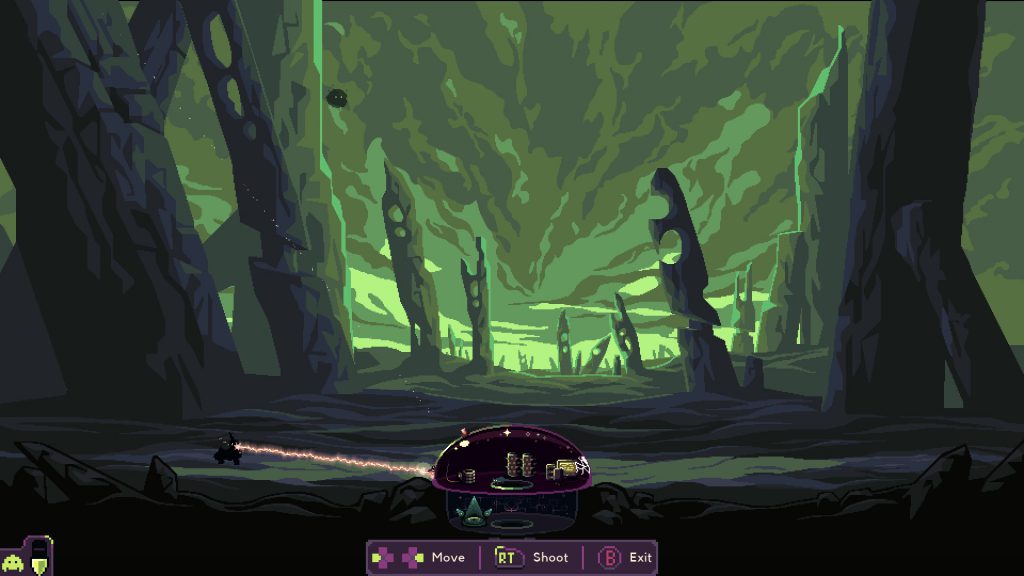
Monster Fighting
The final element of Dome Keeper’s gameplay trifecta is base defense. Every so often, monsters will approach from across the surface of the planet you’ve landed on and attempt to destroy your dome. Losing your dome means losing the game, so you have to prevent this from happening at all costs. Fortunately, this part of gameplay feels fun, and the combat introduces further opportunities for strategic thinking.
Firing a laser feels so darn fun! It’s a straightforward beam of light that melts the health of any monster it hits for as long as you keep it trained on said monster. The effects feel nice and juicy, from the wavy effects of the beam to the small particles that shoot from along the beam trail, from the satisfying shoom sound of the laser to the small controller rumble that happens while I’m opening fire.
Over time, bigger and bigger monsters approach, in greater numbers, so you must upgrade in order to survive. The laser can be made more powerful, and the dome can be improved with greater health and resistance to damage. These upgrades cost the same resources that you use to build up your mining efficacy, so there is a constant tug and pull of when to upgrade your mining to get resource faster and when to upgrade your defense so you can continue to survive.
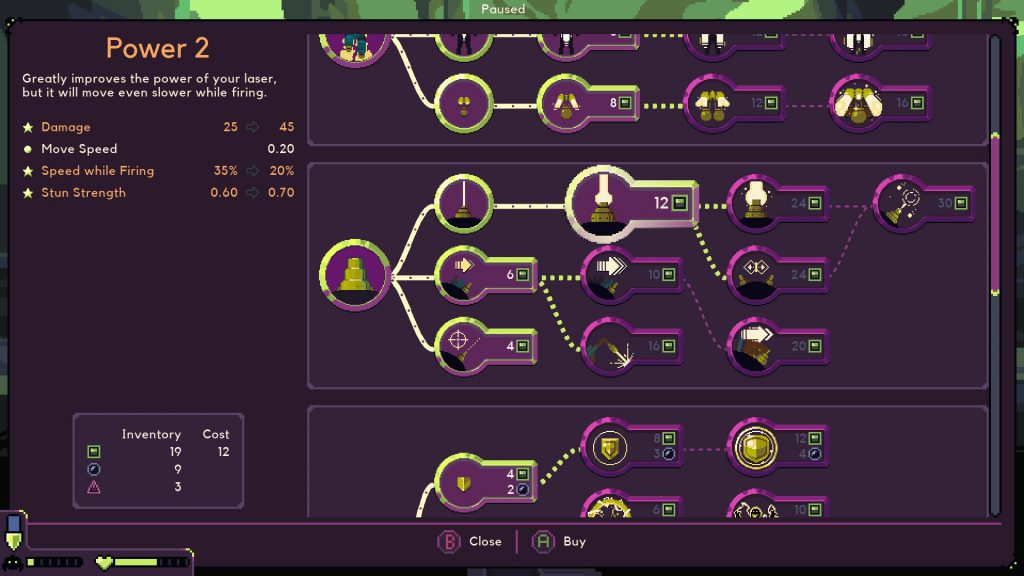
There’s even strategic gameplay in the moment to moment of battle. You can’t move your laser instantaneously, so where you move it to impacts how much damage you take. If you move it to the side with fewer monsters, then that’s more damage coming your way before you can shift the laser back to the other side. If you take enough damage, you need to pop out of laser mode to make repairs (done simply with a payment of cobalt), so you need to make sure you stay on top of how much health you have.
A recent update to Dome Keeper added an upgrade that automatically fixes your dome when it runs out of health, if you have the resources to afford it. It’s something I always get because of how convenient it is, but having it definitely removes a lot of that tension which previously came from managing health in battle.
Overall, fighting the monsters feels good, and figuring out the optimal times to upgrade and the best battlefield tactics for minimizing damage feels continuously interesting. The best moments of Dome Keeper, however, come from when these three tenets of gameplay interact with one another to create thrilling results.
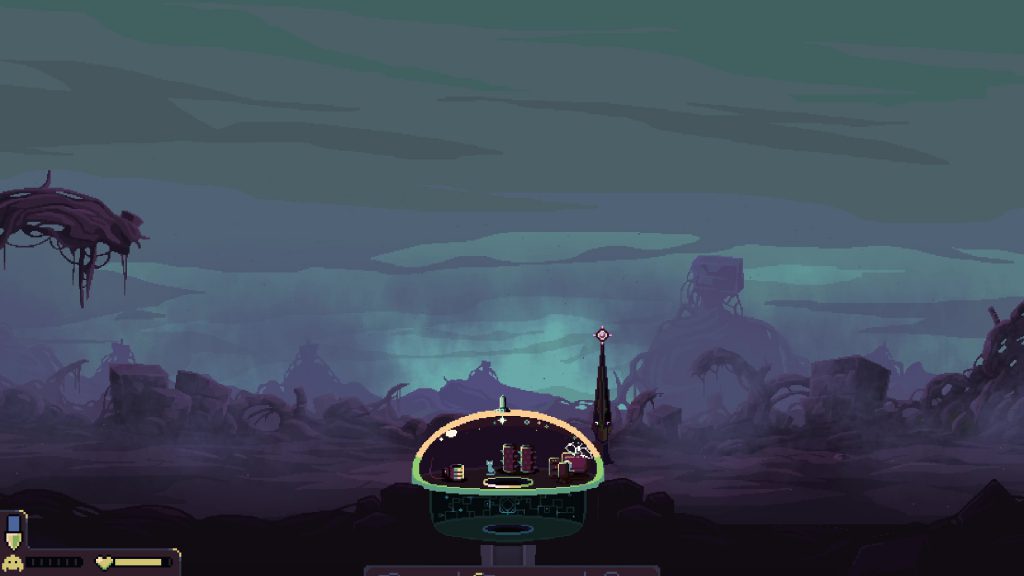
Rush Moments
I’ve already explored some of the ways Dome Keeper’s systems come together to create good gameplay, but there are some more subtle thrills to be had.
While you’re mining underground, you have to keep a constant eye on the monster proximity countdown. Come back too early, and you’ve wasted precious time you could’ve spent doing more digging; come back too late, and you’re going to take some hits and get behind in your defense. If you get things exactly right and dash back into the base just as an attack wave starts, it creates an incredible rush.
Even in failure to calculate things correctly, it still results in powerful feelings, from the panicked adrenaline burst as you scramble back to the tune of the proximity alarm’s beeping to the relief you feel as you exterminate the last monster in a wave with a sliver of health remaining, able to fight another day. Importantly, you aren’t left with the taste of defeat from these moments; you feel as though some bad decision you made was your near downfall, and formulate solutions to prevent yourself from falling into the same bad situation again.
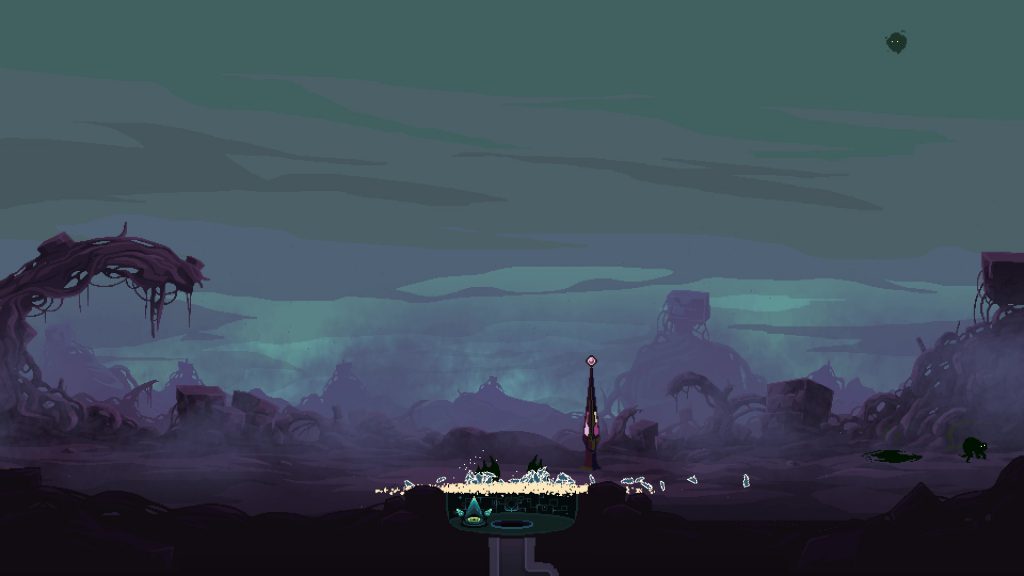
Finally, reaching an endgame moment provides its own thrill. Whether it’s the relic from Relic Hunt mode, to making the decision that you have enough score to trigger the sendoff in Prestige mode, reaching the end goal feels powerful in that the end is in sight, if only you can hold out and play well just a few moments longer. It can even turn into a bit of mastery, where you know you can win right now, but choose to try and play as long as you can, betting on being able to squeak out a win just before becoming overwhelmed.
My Environment
The gameplay itself is enjoyable, but just as important for me is how well it fits my lifestyle. I don’t get much time to play games, I don’t enjoy spending lots of time learning how to play them, and short and sweet games usually don’t feel cool enough for me to enjoy playing them. Dome Keeper manages to hit a sweet spot for all three of those metrics, and I’ll explain how.
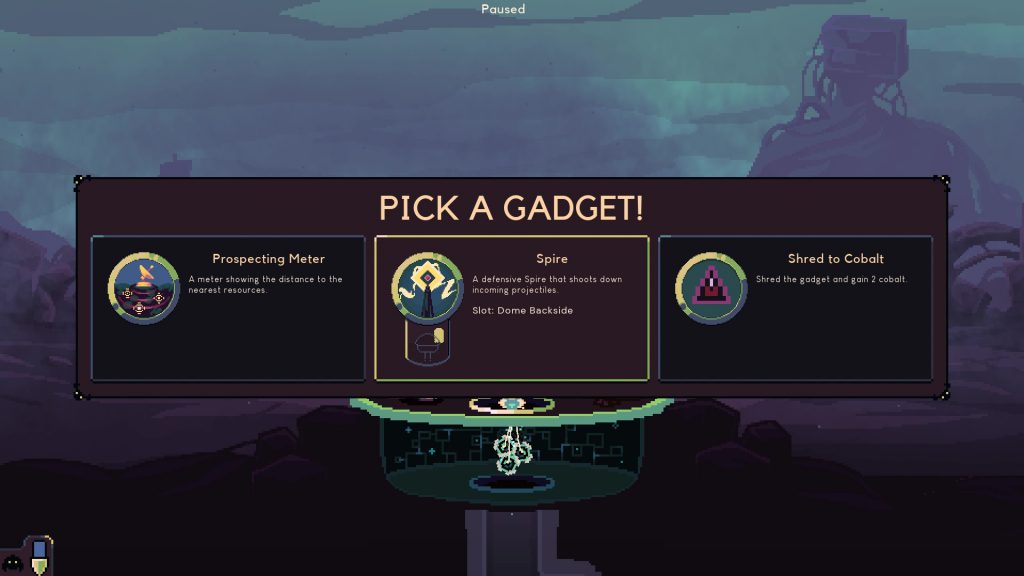
Time Spent
I don’t have much spare time. In addition to spending 40 hours a week doing my day job, I spend at least 16 hours a week on developing my own games, and at least half of the remaining time in various family activities. I simply don’t have time anymore for epic games that cost me dozens of hours of gameplay, like I did as a teenager and in my early twenties.
The gameplay of Dome Keeper is such that I can easily fit a meaningful gameplay session in roughly 20 minutes. It doesn’t feel like I’m hard pressed to end the session, either; a full cycle takes roughly 2-3 minutes, so it’s not hard to find a natural stopping point.

Completing a full round of Dome Keeper takes, at most, a couple of hours. That’s enough time for me to finish a run at least once each week. Game completion gives me a great sense of resolution, even if said run ends in defeat. Comparatively, games with a massive story and lots of content can easily take me months to reach a completion point, and playing the same game that long without resolution leaves me feeling frustrated. Thus, Dome Keeper’s short run time is something I enjoy a lot.
As someone who has a life to live and games to develop, it’s easier for me to enjoy games that have short core sessions and modest run times; in those regards, Dome Keeper’s timing fits my sweet spot almost perfectly.
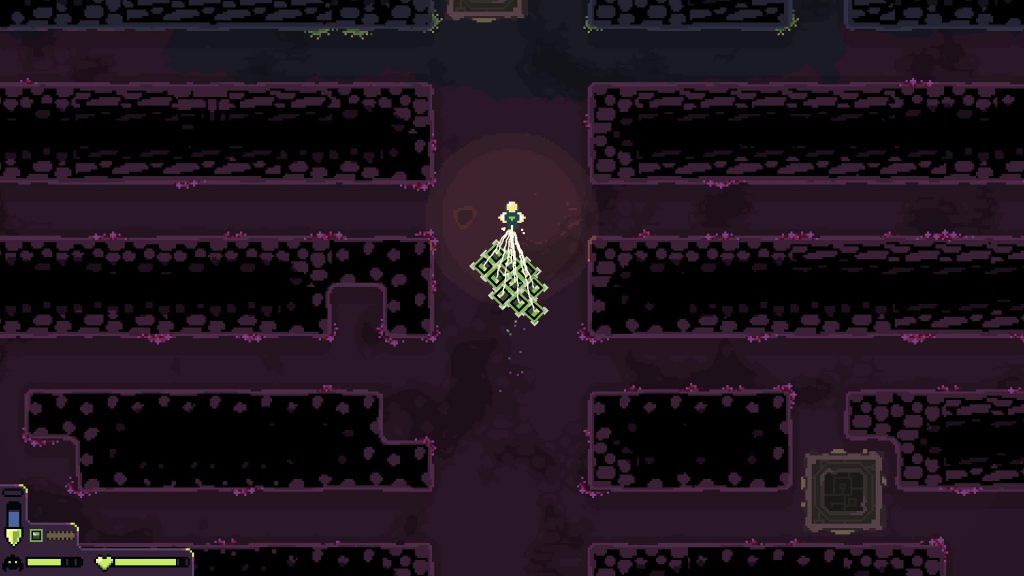
Simplicity
Similarly to how I have less time to play games, I have less time to understand the complexity of a game’s loop. If something takes a lot of time for me to learn, I have a lot less fun playing it; at the same time, if the gameplay is too simple, then it’s boring. Once again, Dome Keeper manages to hit a perfect balance for my tastes.
Having only a small number of resources to manage helps keep the complexity down. The fewer compounding interactions I have to keep track of, the easier it is for me to understand those resource interactions. I think the number three, in particular, is just right. Having only two resources would make for not much challenge at all, and having more than three, while not impossibly complex, would add more information for me to comprehend, and make the game slightly more difficult to get into.
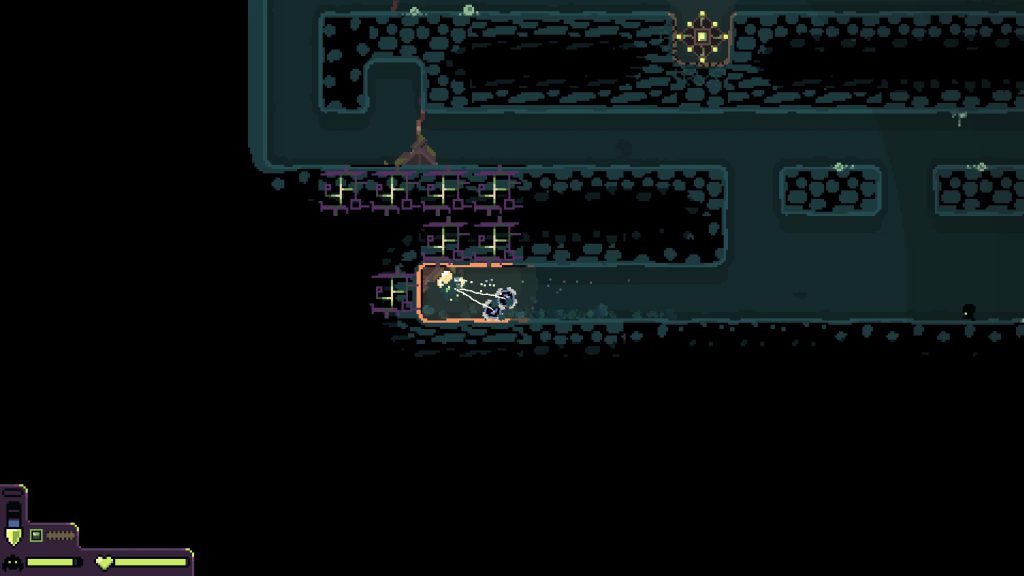
Speaking of complex interactions, Dome Keeper has a lot of them. It may not be obvious at first, though, because those complexities arise from the combination of simple interactions. Buying a drill upgrade? Easy to understand the value. Buying a more powerful laser? Also easy to understand. But what if you only have the resources to buy one upgrade or the other? Less powerful drill means it’ll take longer to get more resources for upgrading, but less powerful laser means you might not have enough firepower to prevent the next wave from doing a lot of damage. Those two simple interactions (upgrading the drill and the laser) combine to form a complex strategic decision, one that changes from run to run depending on the situation I’m in. I love simple ideas that combine to form deep strategies, and Dome Keeper is full of such interactions.
Playing the game almost feels like routine to me at this point. That may sound like a weird thing to speak of in a positive light, but it makes sense for someone in my position. A routine is something I can measure myself against easily to see how well I’m doing. Following the patterns I’ve established are good feels rewarding when I carry them out with maximal efficiency. Finally, that comfy feeling of following a routine is a pleasant break from the stressful challenges I face in my day job, game development efforts, and family life.
Dome Keeper may seem like a simple game to play, with not much time spent doing it. For me, that’s a good combination, and everything feels just complex enough that I don’t get bored of playing it the way that I do.
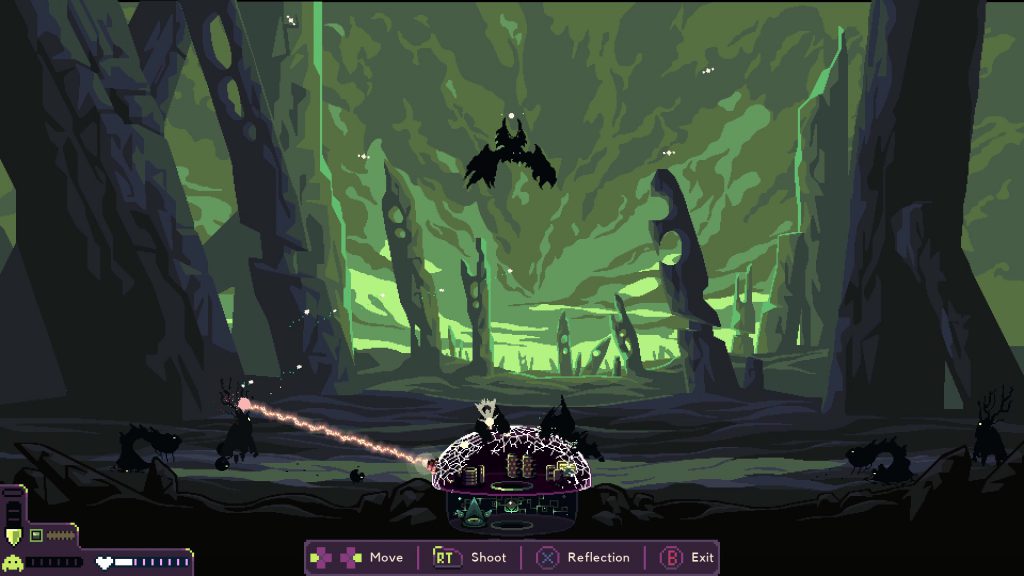
Fun Atmosphere
Finally, the style Dome Keeper is presented in appeals to me. The pixel art is crisp, and easy to read, so it doesn’t take me much effort to read the information I need; it also conveys a good sci-fi atmosphere without needing too much detail. The sound design is great, from the tings of the drill to the crumbling of the rocks to the screams of the monsters as they die. And the music is chill enough to fit well in the background and not pull me out of my mine-digging reverie.
Conclusion
I like Dome Keeper a lot. In studying the game, I’ve realized that its gameplay is a great fit for my interests, and the way it fits into my busy lifestyle makes it easy for me to make small amounts of time to play it.
As a game designer, still working on crafting an enjoyable game, these insights are valuable to keep in mind. I don’t want to design another Dome Keeper, but understanding why I enjoy that game so much aids my own efforts to create games that, hopefully, are just as enjoyable.
